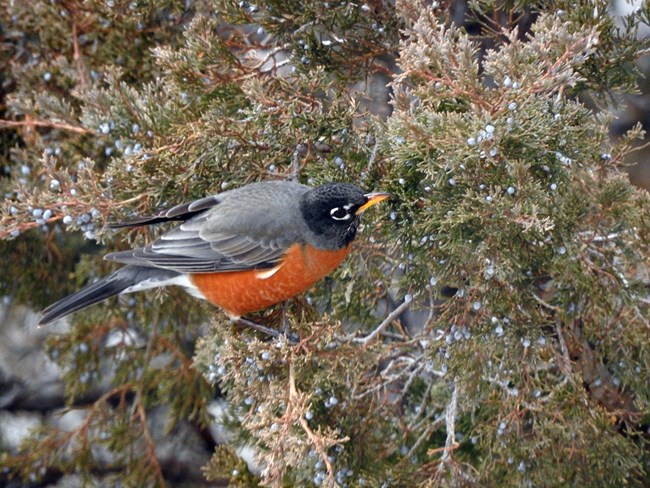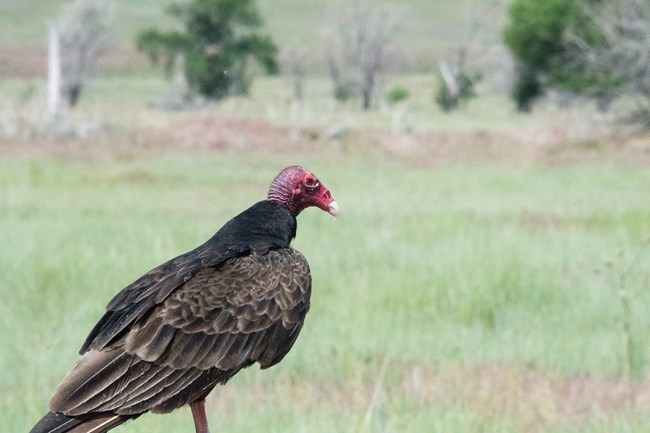Last updated: February 19, 2025
Article
Common Birds of Scotts Bluff National Monument
Year-Round Residents

NPS/Eric Grunwald
American Robin Turdus migratorius
Wingspan: 17 inches
American Robins can be seen throughout Scotts Bluff National Monument. A good place to look for them is on the lawn in front of the visitor center where they can often be seen searching for earthworms. In the winter large flocks sometimes gather near Scotts Spring where they pick juniper berries from nearby trees.

NPS
American Kestrel Falco sparverius
Wingspan: 22 inches
American Kestrels are small birds of prey whose diet includes small rodents, small birds, and insects like moths and grasshoppers. Their favored habitats are meadows, grasslands, farm fields, cities, and suburban areas, therefore they can be found in much of the monument. They are often observed perched on barbed-wire fences, powerlines, or trees.
NPS
Northern Flicker Colaptes auratus
Wingspan: 20 inchesNorthern flickers are woodpeckers that actually spend quite a bit of time on the ground where they forage for ants and beetles, digging them up with their probing bill. They are commonly seen in areas with scattered trees, though they may be observed in different habitats throughout the monument.

NPS
Black-billed Magpie Pica hudsonia
Wingspan: 17 inchesBlack-billed Magpies are very vocal birds with calls that are often described as "sharp" or "petulent". They are flashy and communal birds who they tend to perch on fence posts and road signs just to show their colors and chat. Black-Billed Magpies are omnivores, meaning they can and will eat anything from plants to insects to carrion. In the monument, they are most commonly observed (and heard) at the summit of Scotts Bluff.

NPS/Eric Grunwald
Western Meadowlark Sturnella neglecta
Wingspan: 14.5 inches
Western Meadowlarks are very striking birds with bright yellow chests. They are also vocal birds and it is very common to hear them singing to each other across the plains, especially in the spring. Western Meadowlarks are ground nesters, meaning they build a nest on the ground in a field, grassland, or prairie and cover it with a half roof of grass for slight protection. They are often seen perched on yuccas or small shrubs in the monument.
Macaulay Library, CLO, Ryan Schain
Eurasian Collared-Dove Streptopelia decaocto
Wingspan: 14 inches
Eurasian Collared-Doves are not native to the United States but they are abundantly common within Scotts Bluff National Monument. Originally introduced into the Bahamas, they made their way into Florida and, eventually, most of the rest of the United States. They behave very similarly to the Mourning Dove, a native bird for which they can be mistaken. The Eurasian Collared-Dove is a ground forager, so they tend to spend most of their time on the ground looking for seeds, berries, and insects.They are commonly seen in the area near the visitor center and administration complex.
Summer (Breeding) Birds

NPS/Robert Wagner
Western Kingbird Tyrannus verticalis
Wingspan: 15.5 inches
Western Kingbirds are summer visitors to Scotts Bluff National Monument. They are insectivores. They eat a wide variety of insects, including bees and wasps, grasshoppers and crickets, beetles, moths and butterflies, caterpillars, flies, bugs, and spiders. They build their nests in crotches of trees and in the branches of shrubs like yucca, sagebrush, and Rocky Mountain juniper. They also frequently build nests in human-made structures. They can often be seen near the visitor center where they often build nests under the eaves of building roofs.

NPS/Robert Wagner
Turkey Vulture Cathartes aura
Wingspan: 67 inchesIt's a sure sign of spring when turkey vultures start to be seen gliding on thermals above Scotts Bluff National Monument. With their bald, red head, turkey vultures are distinctive looking birds. They have a keen sense of smell that they use to locate their food: carrion or dead animals. Turkey vultures are most commonly seen soaring above the monument, though they ocassionally perch on rocky outcrops far from areas of the bluff that people frequent.

NPS
Blue Grosbeak Passerina caerulea
Wingspan: 11 inchesBlue grosbeaks prefer a habitat of old fields, forest edges, transmission-line corridors, hedgerows, stream edges, deserts, and prairies like that found at Scotts Bluff National Monument. They feed mostly on insects, though they also eat some grains/seeds. They nest in small trees, shrubs, tangles of vines, briars, or other vegetation, often near open areas or roads. Look for them perched on shrubs in prairie areas of the monument.

NPS/Bandelier National Monument
Rock Wren Salpinctes obsoletus
Wingspan: 9 inchesIf you hike the Saddle Rock Trail on a summer morning, you might encounter a rock wren hopping around looking for a meal of insects or spiders. They prefer a habitat of sparsely vegetated areas with plenty of rock crevices and shade, making the bluffs of the monument a perfect summer home. If you fail to catch a glimpse of a rock wren, you might hear a male wren sing his large repertoire of songs, often mimicking other species of birds.
Winter Birds

NPS/Eric Grunwald
Dark-eyed Junco Junco hyemalis
Wingspan: 9.25 inchesIn some locations juncos are year-round residents, but at Scotts Bluff National Monument juncos can only be found in the winter. As seed eaters, juncos spend considerable time hopping around and pecking at the ground, scratching at leaf litter in their quest for food. During the winter, non-breeding season, they can be found utilizing a variety of habitats, including open woodlands, fields, parks and gardens. Look for them foraging on the ground near the visitor center.

NPS/Eric Grunwald
Canada Goose Branta canadensis
Wingspan: 55 inchesEach winter, thousands of Canada geese descend upon the North Platte River Valley near Scotts Bluff National Monument. Geese are attracted to the area due to the abundance of sandpit lakes along the river while adjacent agricultural lands provide abundant food. The best places to see Canada geese in the monument are along the northern boundary at the North Platte River. You can also see geese flying over the monument in large flocks in their distinctive V-shaped formations.

NPS/Eric Grunwald
Bald Eagle Haliaeetus leucocephalus
Wingspan: 80 inchesIn the winter, bald eagles congregate along major lakes and rivers that have open areas free of ice. This makes the North Platte River prime winter habitat for eagles who rely on fish for 70 to 90 percent of their diet. Besides fish, they might also ocassionally feed on the abundant geese that live in and along the river in the winter. Look for eagles along the North Platte River. You may also ocassionally see them flying over other parts of the monument.

NPS/Eric Grunwald
White-crowned Sparrow Zonotrichia leucophrys
Wingspan: 9 inchesWhite-crowned sparrows visit Scotts Bluff in small flocks each winter. During the winter they eat seeds of weeds and grasses along with grains like corn. You can often observe them "double scratching" the ground as they turn over leaves in their search for food. During winter they use thickets, weedy fields, agricultural fields, roadsides, and backyards. They can be observed throughout the monument, especially in areas that are bordered by agricultural lands.
